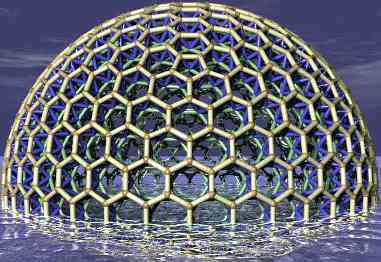
HexDome
Suspension bridge ideas
Here are a few variations on the traditional suspension
bridge that I'm not convinced have been properly
explored.
While I'm an amateur bridge designer, I can't seem to shake
my conviction that the professional designers have somehow
got themselves stuck in a traditional rut - and are probably
wasting millions of taxpayers dollars in the process.
More catenary cables
Here the idea is fairly simple: use additional caternary
cables near the towers, to reduce the height the vertical
suspension cables need to traverse.

More catenary cables
|
This idea keeps the catenary cable near to the body of the
bridge.
That saves a considerable length of vertical suspension
cable.
Some of the weight of the body of the bridge is supported by
the cable that reaches the tower near its base. This weight
no longer has to be supported by the upper part of the tower
- which can consequently be made lighter and more cheaply.
The base of the tower is already likely to be very strong -
and is probably already very well positioned to sustain this
force.
The upper catenary cable no longer has to bear the entire
weight of the bridge - since the regions near the towers
have their weight borne directly by other cables.
Keeping the catenary cable close to the bridge's horizontal
member results in greater stabilising forces against lateral
perturbations.
This design reduces the extent to which the bridge acts like an
aeolean harp - and minimises wind resistance.
The shorter cables have higher notes assocaited with them -
and higher frequencies are more easily damped and are less
likely to result in vibrations.
The lower catenary cable need only carry a small fraction of
the weight of the main catenary cable - and can thus be made
of lighter and cheaper stuff.
The cost of the additional catenary cables is likely to be
greatly outweighed by the cost of all the vertical
cables that are no longer needed, the cheaper towers, and
thinner catenary cables that can be used.
The lower catenary cables should extend right across the
entire length of the bridge. There is likely to be a section in the
middle of the bridge where they run for some distance
horizontal, level with the roadway. That is fine.
Application of the strategy described here can be expected to
reduce both the weight and cost of large suspension bridges
- allowing them to more easily attain larger spans.
Even more catenary cables
The above idea can be applied "recursively" - closer and
closer to the towers.

Even more catenary cables
|
Some existing bridges have partial implementations of this idea:

Brookline bridge
|

Tenkenji bridge
|

Tobiuo bridge
|

Meiko nishi ohashi bridge
|
Slanting struts

Slanting struts
|
Apologies for the primitive nature of this diagram.
Here the idea is to reduce the intensity of the stress point
the cables have endure at the top of the tower.
The overall height of the bridge is reduced slightly in the
process.
Each tower has to bear about one third of the force from the
cables that the original single tower had to bear - so the
cost is not three times as large as using a single tower,
but is broadly comparable.
Additionally, all the towers can be made slightly shorter
than the original one, resulting in some savings.
As a consequence of this ideas, the cables are stabilised by
the towers slightly nearer to the bridge's central point.
The three towers can profitably be connected by cross cables -
again assisting with stability considerations of the entire
structure.
I observe that slanting struts were included in one of the
old proposals for a Gibraltar bridge:

Gibraltar bridge proposal
|
Here the struts extend a substantial distance horizontally -
in what appears to be an attempt to reduce the tensile-only
span.
The slanting struts in this design also act as anchors for
the vertical support cables.
I should add that there are plenty of problems associated
with the idea of slanting struts.
It may sometimes prove beneficial overall - but I
think it would need an exhaustive cost-benefit analysis to
see if it's worth it.
I do think the idea is worthy of further
investigation, though.
For those interested in the history of the ideas described
here, some relics of an earlier page have been preserved
here.
Tim Tyler |
Contact |
http://hexdome.com/
|